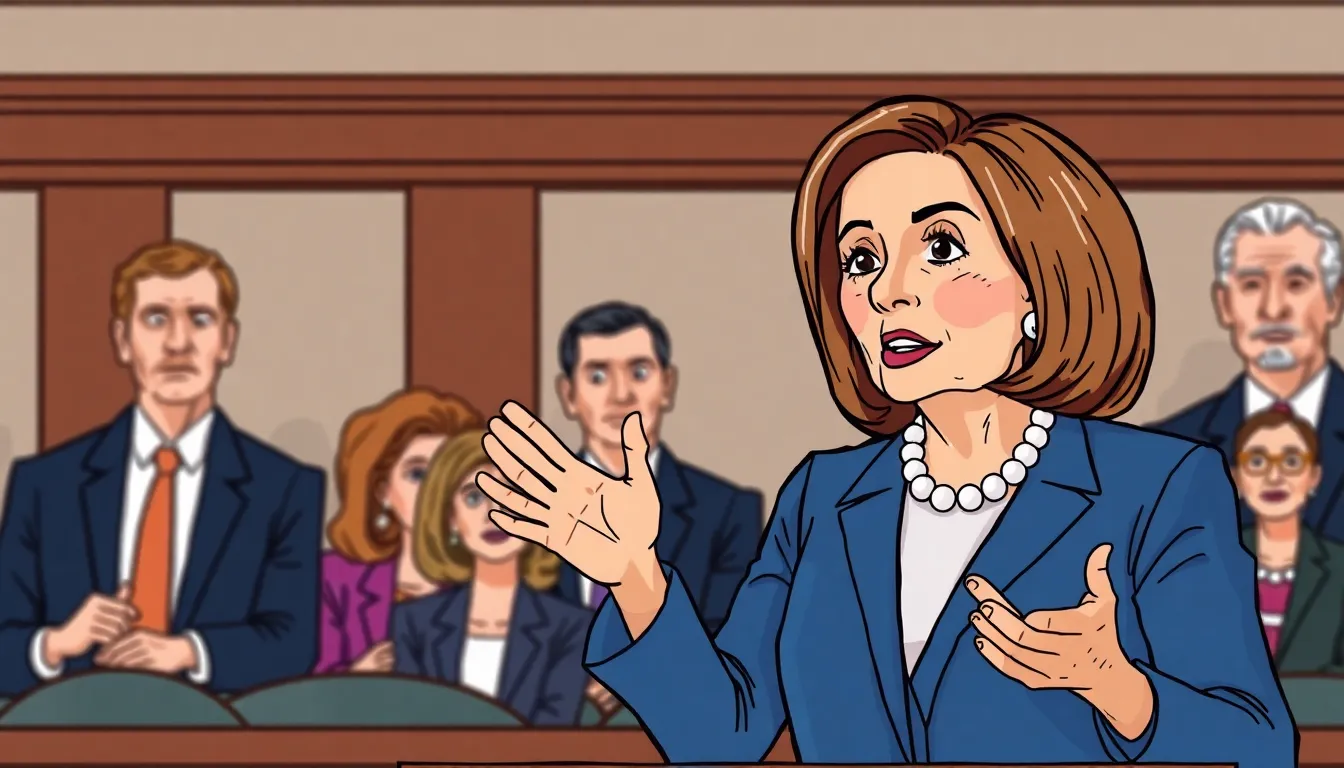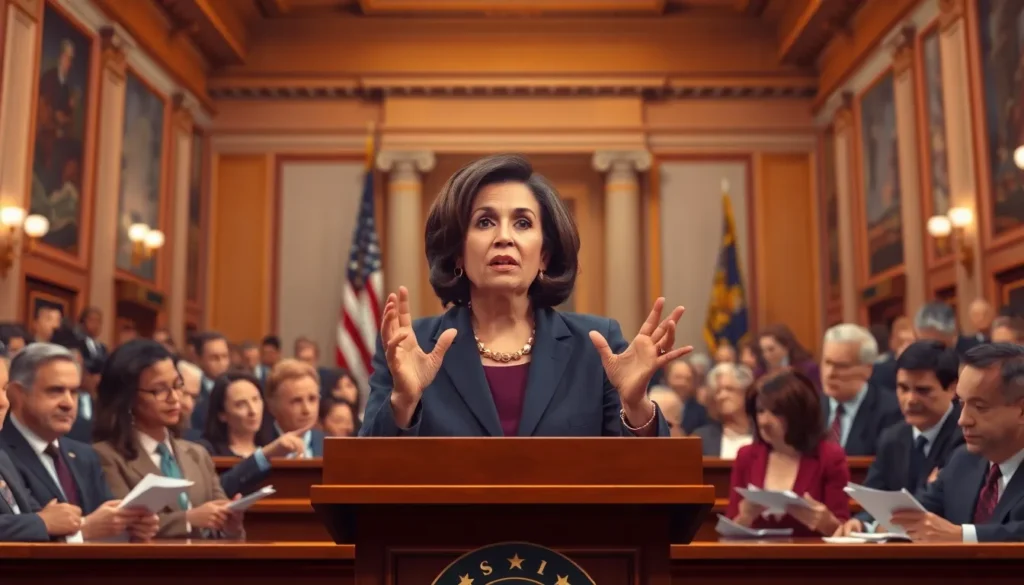In the ever-shifting landscape of American politics, the question of who controls the House of Representatives is like trying to find the last slice of pizza at a party—everyone wants to know, and it can get a little messy. With a mix of power plays, strategic alliances, and the occasional dramatic showdown, the current control of the House is a hot topic that affects everything from legislation to the nation’s mood.
Table of Contents
ToggleOverview of House Control
Current control of the House of Representatives lies with the Democratic Party, holding 222 seats compared to the 213 seats held by the Republican Party. Control influences legislative priorities and policies significantly. The Speaker of the House, Nancy Pelosi, leads the Democratic majority, shaping agenda items and guiding debates.
Party unity plays a crucial role in determining outcomes. Democratic leaders streamline legislation consistent with party platforms, while Republicans often unify to challenge proposals. Key committees, like Appropriations and Judiciary, review and determine the fate of bills, exerting substantial influence within the House.
Recent power struggles reflect shifting alliances and the importance of strategic partnerships. Factions within the Democratic Party, such as the Progressive Caucus, advocate for more ambitious policies, while moderate representatives seek compromise. Challenges emerge when balancing diverse interests amid party control, impacting initiatives on healthcare, economy, and education.
Public sentiment also shapes House control dynamics. Voter concerns over inflation, job growth, and social issues prompt lawmakers to align policies with constituents’ demands. Elections, especially midterms, significantly affect party power ebbs and flows with shifting voter priorities.
Recent debates, driven by issues like climate change and economic recovery, highlight a polarized atmosphere in the House. Members focus on these critical topics, vying for influence and spotlight. As the legislative session progresses, evolving party dynamics will play a vital role in shaping the House’s future direction and policy outcomes.
Key Players in House Leadership

The current leadership in the House of Representatives comprises pivotal figures who guide legislative priorities. Understanding their roles provides insights into the management of the House’s dynamics.
Speaker of the House
Speaker Nancy Pelosi leads the Democratic majority with 222 seats. She orchestrates debates and determines the legislative agenda, positioning her as a significant force in American politics. During debates, Pelosi emphasizes party unity, aiming to streamline legislation consistent with Democratic values. Recent decisions reflect an approach that balances the demands of different factions within her party. Effective communication skills allow her to navigate complex issues while addressing the concerns of constituents. With an ability to rally support for essential bills, Pelosi represents a crucial player in shaping House policies.
Minority Leader
Minority Leader Kevin McCarthy spearheads the Republican response with 213 seats in the House. He rallies party members to unify against Democratic proposals and strategies. McCarthy leverages his leadership to challenge initiatives that don’t align with Republican values. Strategic alliances with influential committee members enhance his ability to influence discussions and promote conservative agendas. Additionally, he engages constituents to ensure their concerns are represented in legislative battles. His role as minority leader highlights the importance of opposition in a polarized legislative environment.
Voting Dynamics and Control
Control in the House of Representatives is shaped by party composition and legislative actions. The current landscape features 222 Democratic representatives and 213 Republican representatives, creating a significant dynamic in voting strength and legislative priorities.
Party Composition
Democrats currently maintain a slim majority in the House. With 222 seats, they leverage their power to advance various bills aligned with party goals. Conversely, Republicans, holding 213 seats, focus on consolidating their collective strength to oppose Democratic initiatives. Each party’s leadership plays a critical role in rallying support, guiding discussions, and setting agendas. Diverse factions within the Democratic party, like the Progressive Caucus and moderate members, often influence legislative strategies and outcomes.
Key Votes and Legislation
Key votes frequently highlight the divisions between parties. Major legislation, particularly on pressing issues like healthcare and spending, showcases these partisan divides. Recent votes reflect a concerted effort by Republicans to unite against Democratic proposals, emphasizing conservative fiscal policies. Democrats, under Nancy Pelosi’s leadership, push for progressive reforms, aiming to fulfill campaign promises. The outcome of these key votes shapes not only legislative priorities but also impacts public sentiment and future electoral strategies.
Recent Changes in House Control
Recent shifts in House control have influenced the political landscape significantly. The Democratic Party currently holds 222 seats, while the Republican Party has 213 seats. This slim majority allows Democrats to pursue their legislative agenda, although challenges remain.
Election Outcomes
Election results in recent cycles underscore the competitive nature of House races. In the 2022 midterm elections, several seats flipped between parties, reflecting voter sentiments and priorities. Gaining ground in suburban districts enabled Democrats to maintain their edge, despite numerous challenges. Conversely, Republicans concentrated their efforts on traditional strongholds to reclaim seats lost in prior elections. Voter turnout played a critical role, with new engagement strategies targeting younger demographics and first-time voters. The evolving electoral landscape set the stage for ongoing battles for control in the House.
Influential Events
Critical events have shaped the current dynamics within the House. High-stakes policy debates, such as those surrounding healthcare and economic relief packages, energized both parties. Major legislative initiatives, including infrastructure spending and climate proposals, ignited passionate discussions, impacting party strategies. The emergence of grassroots movements, advocating for various causes, amplified pressures on House members to respond. Additionally, shifts in public opinion after notable events, like the COVID-19 pandemic, prompted lawmakers to realign their priorities. These developments illustrate how influential moments dictate legislative control and party strategies.
Implications of Current Control
Current control of the House by the Democratic Party significantly influences legislative priorities. With 222 seats, Democrats push key agendas that address pressing issues such as healthcare, infrastructure, and economic relief. Speaker Nancy Pelosi’s leadership plays a vital role in steering discussions and maintaining party unity. Her effectiveness in communication helps rally support for significant legislation, which keeps the focus on party goals.
Opponents from the Republican Party, led by Minority Leader Kevin McCarthy, present counterarguments and advocate for conservative positions. McCarthy’s strategies involve uniting party members against Democratic initiatives while ensuring constituents’ voices remain central in legislative discussions. His ability to forge strategic alliances among Republicans strengthens their stance in a polarized atmosphere.
Recent electoral outcomes illustrate the competitive nature of House dynamics. Voter trends show Democrats gaining traction in suburban areas while Republicans aim to reclaim their traditional bases. Engaging younger voters through innovative strategies has emerged as a critical component for both parties. This ongoing engagement reflects shifting public opinions and heightened expectations among constituents.
High-stakes policy debates ignite fervent discussions and influence strategies on both sides. Issues surrounding infrastructure spending and climate proposals motivate lawmakers to prioritize their responses. Grassroots movements add pressure on House members, pushing them to align their decisions with public sentiment. Notable events, including the COVID-19 pandemic, reshape legislative priorities by prompting lawmakers to adapt to emerging challenges.
The Democratic control of the House establishes a framework for legislative activities. The interplay of party leadership, public engagement, and current political trends contributes to shaping outcomes that impact American lives.
Conclusion
The current control of the House of Representatives by the Democratic Party shapes the legislative landscape in significant ways. With Speaker Nancy Pelosi at the helm the party is poised to drive key initiatives that address pressing national issues. Meanwhile Minority Leader Kevin McCarthy’s efforts to unify Republicans highlight the ongoing power struggle that defines this political environment.
As both parties navigate their respective agendas the influence of public opinion and grassroots movements will continue to play a crucial role in shaping the direction of policy debates. The dynamic nature of House control ensures that the political climate remains fluid and responsive to the needs of constituents across the nation.




